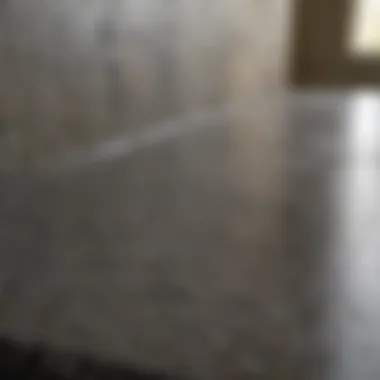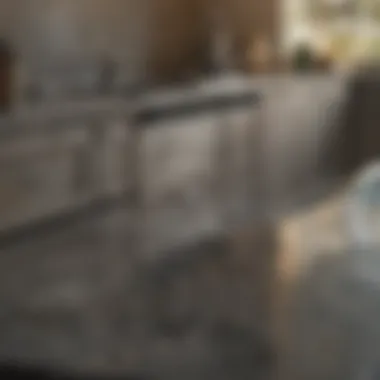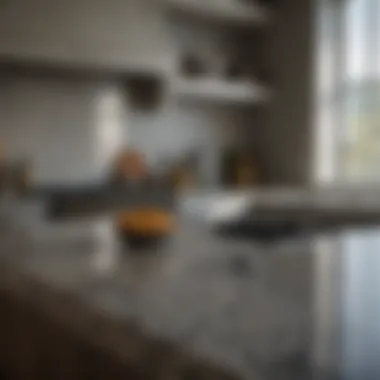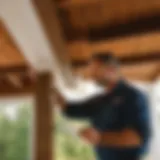Materials:
To start your granite countertops painting project, you will need a variety of materials. Here is a detailed list with exact measurements:
- Primer suitable for countertops: 1 gallon
- Acrylic paint in desired color: 1 quart
- Clear urethane sealer: 1 quart
- Painter's tape
- Paintbrushes: various sizes
- Sandpaper: medium and fine grit
- Tack cloth
- Drop cloths or plastic sheeting
- Soap and water for cleaning
DIY Steps:
Follow these detailed instructions for painting your granite countertops effectively:
- Prepare the countertop surface by cleaning it thoroughly with soap and water.
- Sand the surface lightly with medium grit sandpaper to help the primer adhere better.
- Apply the primer using even brush strokes and allow it to dry completely.
- Once the primer is dry, apply a coat of acrylic paint in your chosen color.
- Use painter's tape to create clean lines if needed.
- Allow the paint to dry completely before applying a second coat if necessary.
- Once the paint is dry, apply a clear urethane sealer to protect the surface.
- Let the sealer dry according to the manufacturer's instructions before using the countertop.
Technical Aspects:
For this DIY project, you will need to pay attention to some technical aspects to ensure a professional finish:
- Timing: Plan your painting project when you have enough time for each coat to dry completely.
- Tools: Use high-quality paintbrushes for a smoother finish.
- Techniques: Apply paint in thin, even coats to prevent drips and brush marks.
DIY Project Process:


Follow these sequential steps for a successful granite countertop painting process:
- Start by gathering all materials and laying down drop cloths to protect your workspace.
- Clean the countertop thoroughly to remove any dirt or debris that could affect the paint adhesion.
- Sand the surface lightly to create a rough texture for the primer to bond to.
- Apply the primer following the manufacturer's instructions and allow it to dry completely.
- Paint the countertop with acrylic paint, using smooth brush strokes to achieve an even finish.
- Seal the countertop with urethane sealer to protect the paint from wear and tear.
- Troubleshooting Tips: If you encounter any issues like bubbles or uneven coverage, sand the surface lightly and apply an additional coat of paint.
Ensure you follow these steps carefully to enjoy a beautifully painted granite countertop that will enhance the look of your kitchen.
Introduction


Granite countertops are renowned for their durability, elegance, and timeless appeal in kitchen spaces. However, if you're looking to refresh your kitchen without the expense of replacing the countertops entirely, painting them can be a cost-effective and creative solution. This comprehensive guide will walk you through the intricate process of painting granite countertops, providing detailed steps to achieve a professional finish and transform the look of your kitchen. By adhering to the tips and techniques outlined in this article, you can breathe new life into your countertops and elevate the aesthetic of your entire kitchen space. Let's delve into the world of painting granite countertops and uncover the strategies and considerations essential for a successful makeover.
Understanding Granite Countertops


In the realm of granite countertops, understanding the characteristics and benefits of this material is paramount for anyone looking to paint them. Granite, known for its durability and timeless beauty, is a popular choice in kitchen design. Its unique composition, predominantly made of quartz, feldspar, and mica, creates a stunning natural appearance that adds elegance to any space. From its hardness to its heat resistance, granite countertops are not only visually appealing but also incredibly sturdy, making them an ideal surface for everyday use. Before delving into the painting process, grasping the essence of granite countertops sets the foundation for a successful renovation project.
Characteristics of Granite
Composition of Granite
When discussing the composition of granite, it's essential to note that each slab is a work of art crafted by geological processes. The mineral composition of granite includes quartz, a mineral known for its hardness and durability, providing the countertop with resilience against scratches and wear. Feldspar, another prominent component, contributes to granite's aesthetic appeal by displaying a range of colors and patterns. Mica, with its shiny appearance, adds a touch of glamour to the surface. This unique blend of minerals results in a hard-wearing material that withstands the demands of a busy kitchen, making it a favored choice for homeowners seeking both functionality and beauty in their countertops.
Durability of Granite
The durability of granite stems from its innate strength and resistance to heat and pressure. Granite is formed through the slow crystallization of magma deep within the earth's crust, which results in a dense and durable stone surface. This natural process imbues granite with exceptional durability, able to withstand high temperatures without damage. Additionally, its resistance to scratches and stains ensures that granite countertops retain their exquisite appearance even after years of use. The robust nature of granite makes it an ideal canvas for painting, as the surface can endure the application process and maintain its integrity over time.
Benefits of Painting Granite Countertops
Transforming granite countertops through painting opens up a world of possibilities for customization and rejuvenation.
Cost-Effectiveness
Painting granite countertops offers a cost-effective alternative to complete replacement. By repainting existing countertops, homeowners can achieve a fresh look without the hefty price tag of purchasing new materials. This affordability makes painting a practical choice for those looking to update their kitchen aesthetics on a budget. Furthermore, the ability to choose from a wide range of paint colors allows for personalized design options that align with individual style preferences.
Customization Options
One of the primary benefits of painting granite countertops lies in the extensive customization options it provides. Unlike natural granite, which offers limited choices in appearance, painting allows for limitless creativity. With various painting techniques and color combinations available, homeowners can tailor their countertops to match evolving style trends or personal tastes. Whether aiming for a sleek modern finish or a rustic textured look, painting offers the flexibility to achieve the desired aesthetic without the constraints of natural stone patterns.
Preparation
The preparation stage is of utmost importance when undertaking the task of painting granite countertops, as it sets the foundation for a successful and long-lasting finish. Proper preparation ensures that the paint adheres well to the surface, giving you a professional look. Before beginning the painting process, thorough cleaning of the countertops is essential to remove any dirt, grease, or stains that could interfere with the paint adherence. Additionally, priming the surface helps in creating a smooth and uniform base for the paint to be applied. Taking time to prepare the countertops adequately will lead to a more durable and visually appealing result.
Cleaning
To ensure a flawless paint finish on your granite countertops, cleaning is a crucial step that cannot be overlooked. Removing stains from the surface is vital to prevent any discoloration or blemishes from showing through the paint. By selecting appropriate cleaning agents and applying them correctly, you can effectively eliminate any existing stains and dirt buildup. Degreasing the surface further ensures that the paint adheres evenly without any issues. This step is essential in guaranteeing a smooth and professional-looking outcome.
Removing Stains
The process of removing stains from granite countertops involves employing specialized cleaners or natural remedies to lift the discoloration without damaging the stone. Utilizing gentle yet effective solutions tailored for granite surfaces helps in preserving the integrity of the material while ensuring thorough stain removal. This meticulous approach is necessary for achieving a flawless paint application, as any remnants of stains can compromise the final result.
Degreasing the Surface
Degreasing the granite surface is crucial to eliminate any oil or grease buildup that could prevent the paint from adhering properly. Using degreasing agents specifically formulated for granite helps in breaking down stubborn grease deposits without harming the stone. This prepares the surface for priming and painting, allowing the subsequent layers to bond effectively for a lasting finish.
Surface Priming
The next step in preparing granite countertops for painting is surface priming, which involves selecting the right primer and applying it correctly to enhance paint adhesion and longevity. Choosing a primer designed for use on stone surfaces ensures optimal adhesion and durability of the paint. By meticulously priming the surface with the appropriate product, you create a strong foundation for the paint to bond, preventing peeling or chipping in the future.
Choosing the Right Primer
Selecting a high-quality primer specifically formulated for granite ensures excellent adhesion and coverage, promoting a professional finish. The primer should be compatible with stone surfaces and designed to withstand daily wear and tear. Considering factors such as primer type and compatibility with the chosen paint color is crucial for achieving the desired results.
Applying the Primer
Applying the primer evenly and in thin layers is key to achieving a smooth and flawless base for the paint. Using a brush or roller designed for smooth surfaces helps in distributing the primer evenly, ensuring full coverage and optimal adhesion. Following the manufacturer's instructions for drying times and reapplication intervals is essential to maximize the primer's effectiveness and prepare the surface adequately for painting.
Painting Process
When it comes to painting granite countertops, the painting process is a crucial step in achieving a professional and long-lasting finish. This section will delve into the intricacies of selecting the right paint, applying it correctly, and layering for optimal coverage.
Selection of Paint
To begin the painting process effectively, choosing the right type of paint suitable for granite is paramount. The type of paint you select will determine the overall durability and appearance of your painted countertops. Consider factors like the paint's adhesion properties, resistance to stains, and its compatibility with granite surfaces. Opt for acrylic or epoxy-based paints specifically formulated for use on hard surfaces like granite.
Types of Paint Suitable for Granite
Acrylic paints are popular for granite countertops due to their excellent adhesion and durability. These paints are resistant to chipping, fading, and staining, making them a practical choice for high-traffic areas like kitchens. Epoxy paints, on the other hand, offer superior strength and chemical resistance, ideal for protecting granite surfaces from daily wear and tear. Both options provide a smooth and easy-to-clean finish, ensuring your painted countertops maintain their aesthetic appeal for years to come.
Application Techniques
After selecting the appropriate paint, mastering the application techniques is essential for a flawless finish. Whether you opt for the roller method or the brush method, understanding how to apply the paint evenly and efficiently will greatly impact the end result.
Roller Method
Utilizing a roller for painting granite countertops offers quick coverage and a streak-free finish. The key advantage of the roller method is its ability to evenly distribute the paint over large surface areas, reducing the risk of visible brush strokes or uneven application. Additionally, rollers come in various nap lengths, allowing you to customize the texture of the painted surface to achieve your desired look.
Brush Method
While the brush method may be more time-consuming, it grants greater precision when painting intricate details or edges on your countertops. Brushes provide greater control over the paint application, ensuring no spots are missed and corners are adequately covered. Opt for high-quality brushes with fine bristles to achieve a smooth and professional finish.
Layering
Layering plays a vital role in enhancing the durability and coverage of painted granite countertops. Applying multiple thin layers of paint not only improves color richness but also strengthens the paint's adhesion to the surface.
Building Layers for Coverage
Building layers of paint gradually allows for better control over the final color intensity and texture of your countertops. Thicker layers of paint may lead to uneven drying and potential cracking, so it is advisable to apply several thin coats, allowing each layer to dry completely before the next application. This method ensures a seamless and long-lasting finish that can withstand daily use and cleaning routines.
Finishing Touches
In the final stages of painting your granite countertops, the finishing touches play a crucial role in ensuring a polished and long-lasting outcome. The completion of the painting process with finesse is essential for achieving a professional look that enhances the aesthetics of your kitchen. Emphasizing on details such as sealing the paint and overall cleanliness adds a layer of sophistication to the newly painted surface, elevating the visual appeal of your countertops. Moreover, the post-painting maintenance tips are vital for preserving the beauty of the granite surface and ensuring its durability over time.
Sealing the Paint
Protecting the Surface
When it comes to the protection of the painted surface on your granite countertops, the sealing process acts as a shield against stains, moisture, and wear and tear. By sealing the paint effectively, you prevent any damage that could occur from spills, heat exposure, or cleaning agents. The protective layer formed by the sealant not only safeguards the painted surface but also enhances its resistance to daily use, making it a practical choice for maintaining the appearance of your countertops in the long run. The durability of the protected surface ensures that your investment in painting the granite pays off by extending its lifespan and maintaining its pristine look.
Enhancing Durability
Enhancing the durability of the painted granite countertops is essential for increasing their resilience and longevity. The process of sealing the paint not only protects the surface but also reinforces its strength, making it more resistant to scratches, chipping, and fading. By enhancing the durability of the painted surface, you ensure that your countertops maintain their fresh appearance even after continuous use. This added robustness is particularly beneficial in high-traffic areas like the kitchen, where countertops are subjected to various activities daily. Investing time and effort in enhancing the durability of your painted granite countertops guarantees a lasting and elegant finish.
Cleaning Up
After completing the painting process and sealing the paint, attention to detail in the cleaning up phase is essential to achieve a flawless result. Removing painter's tape meticulously ensures clean and sharp edges, giving your countertops a neat and professional look. The precision in this step contributes to the overall aesthetics of the painted surface, creating a seamless transition between the painted area and the surrounding kitchen elements. Additionally, implementing effective cleanup tips post-painting not only maintains the cleanliness of the countertops but also prevents any residue or smudges that could detract from the beauty of the newly painted surface.
Removing Painter's Tape
Efficiently removing the painter's tape is crucial in achieving crisp lines and defining the boundaries of the painted area on your granite countertops. This step demands careful peeling to avoid damaging the paint or leaving behind any adhesive residue. The precise removal of the tape ensures that the edges of the painted surface appear clean and sharp, enhancing the overall visual impact of the countertops. By executing this task with attention to detail, you elevate the professionalism of the paint job, creating a seamless finish that mirrors the precision of professional painting services.
Cleanup Tips
Implementing effective cleanup tips post-painting is essential for maintaining the pristine appearance of your granite countertops. From wiping down the painted surface with a gentle cleaner to ensuring all painting tools are properly cleaned and stored, each cleanup tip contributes to the longevity of the paint finish. By following these simple yet crucial guidelines, you preserve the beauty of your painted granite countertops and keep them looking fresh for an extended period. Embracing these cleanup practices not only enhances the aesthetics of your kitchen but also reflects your dedication to meticulous maintenance, ensuring a lasting impact of your painting project.
Maintenance Tips
In the realm of painting granite countertops, the significance of maintenance cannot be overstated. It is essential to ensure the longevity and aesthetic appeal of your newly painted countertops. By implementing effective maintenance strategies, you can preserve the beauty of the painted surface and protect it from wear and tear over time.
Maintaining granite countertops involves a two-fold approach: avoiding abrasive cleaners and adhering to regular maintenance practices. These tips are crucial in safeguarding the painted finish and extending the lifespan of your countertops. By understanding and implementing these maintenance guidelines, you can enjoy the fresh look of your kitchen for years to come.
Long-Term Care
Avoiding Abrasive Cleaners
One key aspect of long-term care for painted granite countertops is avoiding the use of abrasive cleaners. Abrasive cleaners contain harsh chemicals and abrasive particles that can scratch the painted surface, causing irreversible damage. By steering clear of these harsh cleaning agents, you ensure that the painted finish remains smooth and intact.
The key characteristic of avoiding abrasive cleaners is its gentle yet effective cleaning action. Unlike traditional abrasive cleaners that can dull or scratch the surface, opting for milder alternatives preserves the integrity of the paint. This choice is particularly beneficial for painted granite countertops, where maintaining a flawless finish is paramount.
Avoiding abrasive cleaners offers a unique feature of ensuring the longevity of the paint. By choosing gentle cleaning products, you protect the painted surface from premature wear, maintaining its vibrant appearance. This practice not only enhances the durability of the paint but also sustains the overall aesthetic of the countertops.
Regular Maintenance Practices
Another crucial aspect of long-term care for painted granite countertops is the implementation of regular maintenance practices. Consistent upkeep is essential for preserving the pristine look of the painted surface and preventing dirt and grime buildup. By incorporating regular maintenance routines, you can ensure that your countertops retain their luster and beauty.
The key characteristic of regular maintenance practices is their preventive nature. By routinely cleaning and caring for your painted granite countertops, you proactively address any potential issues and maintain a clean and hygienic surface. This proactive approach minimizes the risk of extensive staining or damage, prolonging the life of the paint.
Embracing regular maintenance practices offers a unique feature of convenience and efficiency. By establishing a set maintenance routine, you streamline the upkeep process and effectively manage the cleaning tasks. This efficient approach not only saves time and effort but also preserves the appearance and condition of your painted countertops.





